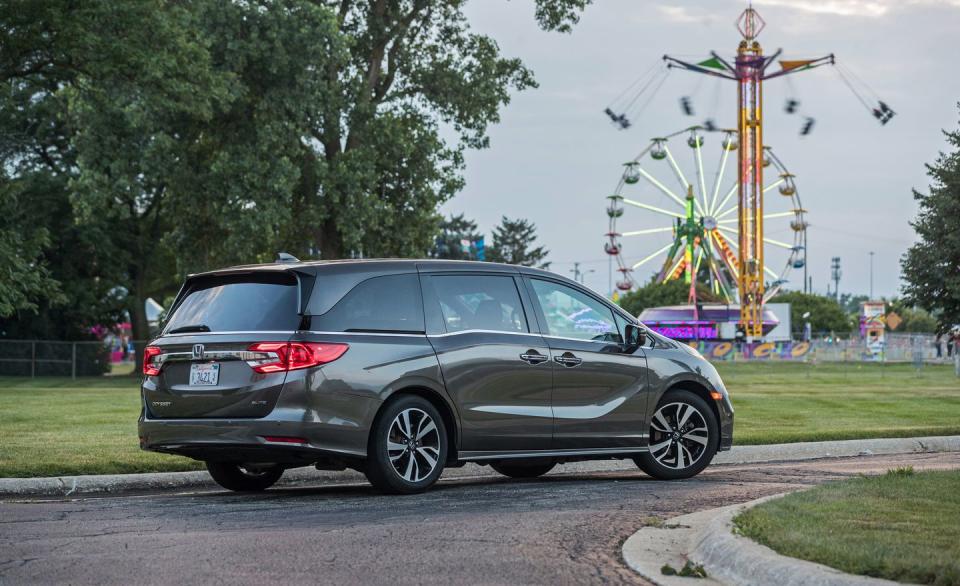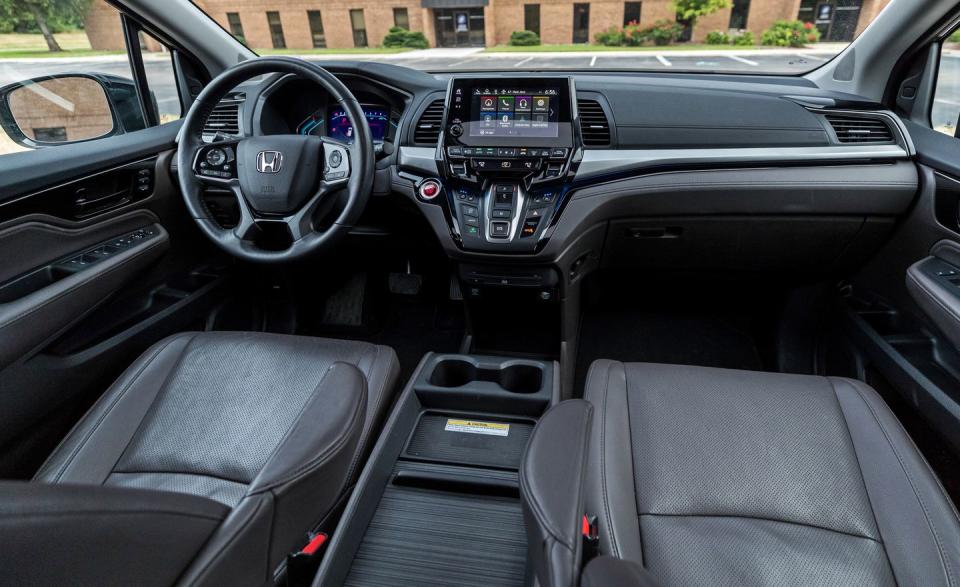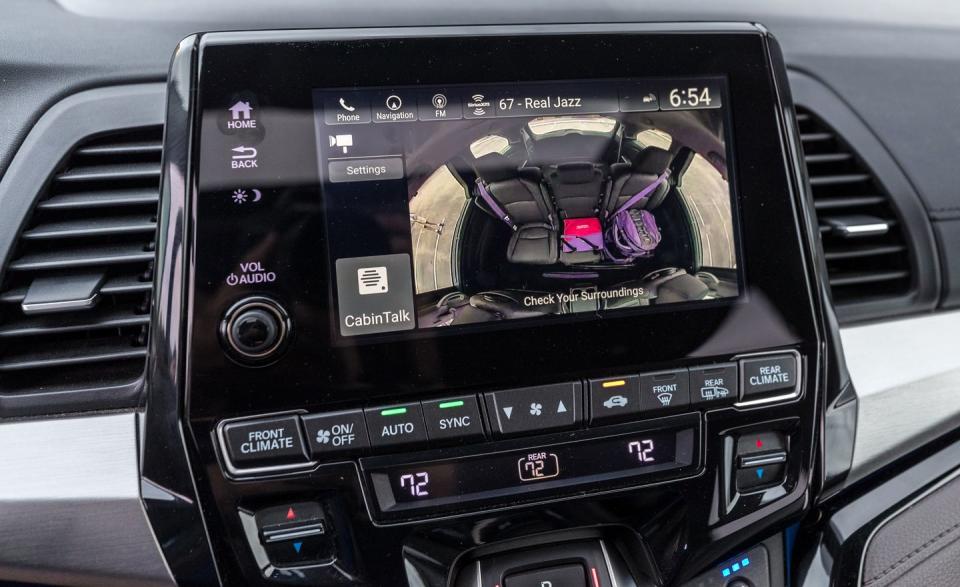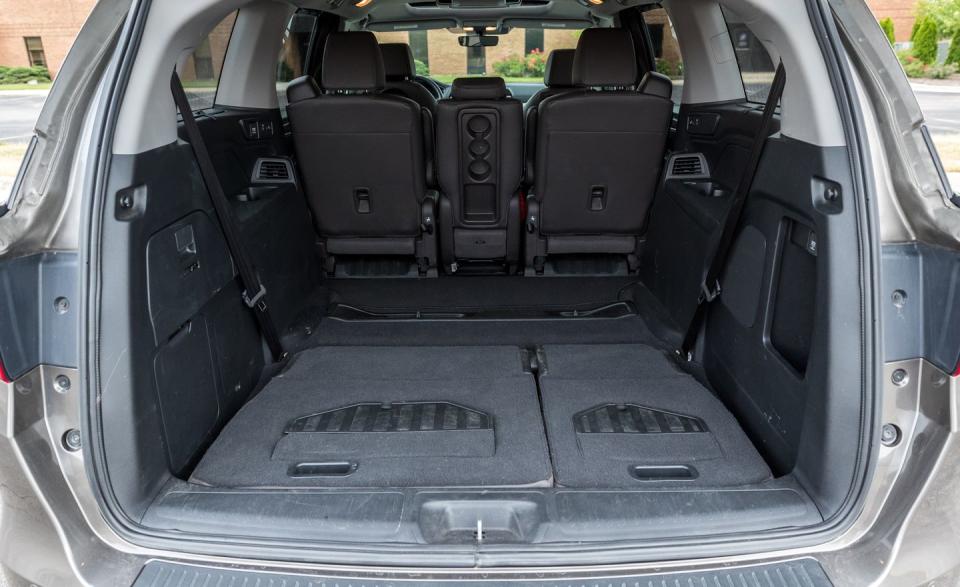2018 Honda Odyssey Long-Term Test Verdict: It's Neck and Neck at the Top of the Minivan Segment
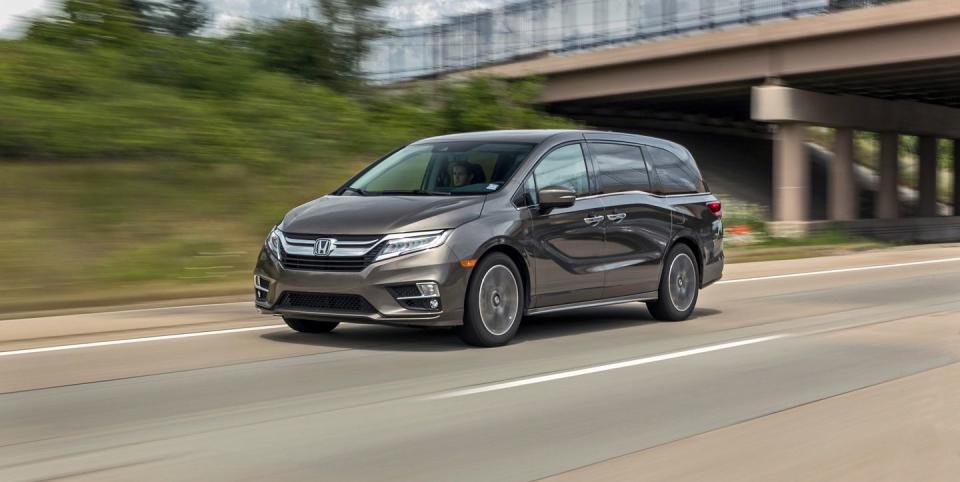
Whether by stigma, buyer preferences toward SUVs, or some sinister combination of both reasons, the minivan market has shrunk as if it's just waded into frigid water. Only a handful of players remain, and among those there is a clear division between the best-Chrysler's Pacifica and Honda's Odyssey-and the rest.
Running Costs Compared
Coincidentally, we're completing our 40,000-mile long-term test of Honda's latest Odyssey only a few months after wrapping up our identical test of a Chrysler Pacifica. (We've now also added a plug-in Pacifica hybrid to the fleet-because we like minivans, can't you tell?) With a combined 80,000 miles of seat time in the two vans, we've garnered extensive firsthand experience with what separates them (beyond the fact that the Pacifica earned our nod for a 10Best Trucks and SUVs award for Best Minivan two years running).
It isn't running costs: The Odyssey averaged 23 mpg during its stay with us, while the Pacifica was just behind it at 22 mpg. The Honda's $566 in service costs was almost identical to what we spent on the Pacifica: $572. The only out-of-the-ordinary service the Honda required was a pair of replacement rear window switches around 17,000 miles, which was covered under warranty, and an infotainment issue detailed below. If a built-in vacuum cleaner is a must-have, both the Pacifica and the Odyssey offer one, although the Pacifica makes you give up the spare tire to get it. Neither van represents particular value relative to the other-although the Honda comes standard with many active-safety features that are optional on the Chrysler-and both can be optioned to near $50,000. However, the Honda retains its value far better. According to ALG, after two years and 30,000 miles, an Odyssey that stickered at $45,000 is worth $9000 more than an equivalent Pacifica. And as we've mentioned, Chrysler offers a plug-in-hybrid version of the Pacifica; Honda offers no hybridized Odyssey equivalent.
Where Each Excels
A few key subjective preferences are what separate the Honda and Chrysler atop the minivan pedestal. We can guarantee that your selection of one van over the other will come down to your desires surrounding handling, rear-seat comfort, and cargo-hauling flexibility-the three primary areas in which the Odyssey and Pacifica diverge. The good news? Should the Honda's alchemy not tickle your fancy, chances are the Pacifica's will. This is what makes the two minivans' battle so tit-for-tat: Each van trades competencies catering to different audiences.
Over 40,000 miles of testing, the Odyssey distinguished itself as the driver's choice in the minivan segment. It absolutely does not feel like a mail truck from behind the wheel, thanks to its well-sorted, firmly damped suspension; accurate steering; and athletic 280-hp 3.5-liter V-6 engine. When new, the Honda laid down an impressive 6.7-second zero-to-60-mph time; at the end of 40,000 miles, its acceleration didn't change. The Pacifica was 0.6 second slower than the Odyssey when new, closing the gap by only 0.1 second by the end of its stay with us.
Because Honda and Chrysler seemingly refuse to shade each other's vans in any way save for their basic shapes, the two use different shifter layouts, each unique in their own ways. The Pacifica uses a large knob, while the Odyssey employs Honda's newfangled pushbutton controls. Since we've already experienced these buttons in our long-term Pilot-and, more recently, in our Accord sedan and our Ridgeline pickup-most drivers were used to the arrangement, which escaped complaint throughout the test. To recap, park is activated via a button, reverse functions via a pull-back tab (sort of like a window switch), and neutral is another button, as is drive; these controls are organized in a line and follow the PRNDL configuration. There is no "low" setting, but pressing the drive button twice activates a Sport mode.
Dynamic problems were few. The Odyssey posts far longer braking distances from 70 mph than does the Chrysler, and its brake pedal swings through a squishier arc. Our van wasn't included in the recall to address soft brake pedals in Odysseys. We also recorded an average 0.77-g skidpad-grip figure, whereas the Pacifica posted a '90s-sports-car-like 0.89 g at the end of its test. Blame the Honda's rather narrow, comfort-minded Bridgestone tires; the Pacifica rides on a more aggressive set of Michelins. Drivers also complained that the Odyssey's accelerator pedal needed to be pressed rather far to wake up the V-6 and 10-speed auto powertrain combo (lesser models use a nine-speed), but once prodded, it proved spry enough to scoot the van into gaps in traffic. Overall, the Honda feels lighter on its feet and more willing to be driven aggressively than the Chrysler, although some drivers found the combination of the crisp suspension tuning and 19-inch wheels that come on the top Touring and Elite trims too firm, preferring to trade the Honda's eager handling and road feel for the Pacifica's cushier ride and greater road isolation. Everyone, however, appreciated how easy it was to find a comfortable driving position in the Honda.
Infotainment Woes
Chrysler has Honda beat in the minivan infotainment system wars. Early in the Odyssey's test, its logbook overflowed with tales of woe centered around a nonfunctional touchscreen display. Remote starting the Honda or sometimes merely starting it the old-fashioned way from inside the vehicle would result in a blacked-out touchscreen, no audio, and occupant confusion. Sometimes, the display would flicker back to life later, other times it could be revived by the following process: killing the ignition, exiting the vehicle, locking the doors and arming the alarm, unlocking the doors, reentering the vehicle, and restarting the car. A rather inconvenient procedure just to get the radio to work.
After a local dealer verified our issue, it worked with Honda's tech support to determine that our Odyssey needed a new digital audio tuner unit. This was installed at no charge (the list price for the component is $594, not including installation), and the problem vanished. Later, Apple CarPlay began acting up, an issue quickly resolved with a software update. We also had an issue where the active-noise-cancellation system was adding a booming noise rather than subtracting sound when coasting at certain speeds. Our dealer never fixed that one, but there's now a technical service bulletin that calls for replacing the electronic control module for that system.
Which brings us to the (functioning) Honda infotainment screen's menus, which, intuitive and responsive to touch inputs though they may be, fall just short of Chrysler's brilliant Uconnect system. Ditto the Odyssey's flip-down rear-seat entertainment screen, an option on the EX-L trim and standard on the Touring and Elite. The single screen is old-school compared to the dual tablet-like touchscreens that came affixed to the backs of both front seats in our long-term Pacifica, which offer built-in games and don't block the driver's view out the back when in use. On the flip side, the Honda's display is visible from both the second- and third-row seats; those in the Chrysler's third row would need to peer diagonally at one of the two touchscreens to watch a movie.
Seats for Sitting or for Stowing
More than any other Honda-versus-Chrysler battle, the second-row seats were a source of disagreement amongst our staff. Chrysler sells the Pacifica with its clever Stow 'n Go second-row chairs, which can fold into cubbies beneath the floor. Folding them and the third-row seats creates a broad, flat load floor between the front seats and the liftgate. When the Stow 'n Go chairs are not stowed, the wells they can tumble into function as vast hidden storage compartments. That versatility is a big reason behind the Chrysler receiving our nod as best minivan-one that doesn't apply to the hybrid model, which foregoes the folding seats and cubbies, filling the underfloor space with batteries instead.
Some holdouts weren't so convinced, preferring instead the Honda's vastly more comfortable second-row captain's chairs, which, unburdened from the requirement that they fold into the floor, boast thicker padding. (The same is true for the Pacifica hybrid's non-stowing seats, and the no-cost eight-passenger option of gas-only Pacificas.) The Odyssey's captain's chairs are thus bulky and heavy, a liability when it comes time to remove them to make way for vehicle-filling cargo. (Owners may also choose to simply fold the seatbacks forward and stack stuff atop the chairs.) Once removed, the seats also leave behind a lumpy floor surface that isn't as kind to slide-in cargo such as boxes or slabs of wood. Easier to remove is the narrow middle seat, which fits between the Honda's second-row chairs and can be slid forward so that parents might reach a small child from the front seats if needed. Still, if you plan to regularly transition your minivan between people- and cargo-toting roles, the Pacifica is our hands-down recommendation; if you only make epic Home Depot runs once or twice a year, the Honda's rear seats are kinder to the human cargo you'll carry.
After some 80,000 miles of vanning in the last few years, we'll put it this way: If maximum seat flexibility, ride comfort, and sleek looks are priorities, then the Pacifica is more your jam. Those seeking maximum seating comfort and the best possible minivan-driving experience should sign up for an Odyssey. That's what online deputy editor Dave VanderWerp did-he purchased this very Honda at the end of its test, and it's now parked in his garage alongside a 1991 Acura NSX. You won't be disappointed by either van, provided you chose the one that fits your use case.
Months in Fleet: 13 months Current Mileage: 40,022 miles
Average Fuel Economy: 23 mpg
Fuel Tank Size: 19.5 gal Observed Fuel Range: 440 miles
Service: $566 Normal Wear: $0 Repair: $0
Damage and Destruction: $0
('You Might Also Like',)

 Yahoo Autos
Yahoo Autos 